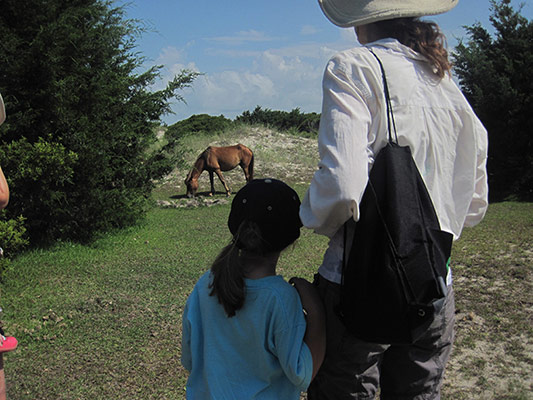Last updated: March 30, 2018
Lesson Plan
Horses and Humans: Shackleford Horses Unit

- Grade Level:
- Upper Elementary: Third Grade through Fifth Grade
- Subject:
- Literacy and Language Arts,Math,Science
- Lesson Duration:
- 90 Minutes
- Common Core Standards:
- 3.L.6, 3.RI.3, 3.RI.7, 3.RI.10, 4.RI.1, 4.RI.3, 4.RI.4, 4.RI.7, 4.RI.9, 4.RI.10, 5.RI.1, 5.RI.4, 5.RI.9, 5.RI.10, 3.W.8
- State Standards:
- NC Essential Standards: Science: 4.L.1; 4.L.1.2; 4.L.1.4; 5.L.2; 5.L.2.2; 5.L.3.2
- Additional Standards:
- Next Generation Science Standards: 3-LS2; 3-LS2.D; 3-LS3; 3-LS4; 4-LS1; 4-LS1-2; 5-ESS3
- Thinking Skills:
- Remembering: Recalling or recognizing information ideas, and principles. Understanding: Understand the main idea of material heard, viewed, or read. Interpret or summarize the ideas in own words. Applying: Apply an abstract idea in a concrete situation to solve a problem or relate it to a prior experience. Analyzing: Break down a concept or idea into parts and show the relationships among the parts. Creating: Bring together parts (elements, compounds) of knowledge to form a whole and build relationships for NEW situations. Evaluating: Make informed judgements about the value of ideas or materials. Use standards and criteria to support opinions and views.
Objective
This science & math unit features the wild horses of Shackleford Banks. See attached complete unit.
Background
See attached complete unit.
Preparation
Materials
Powerpoint program allows students to evaluate whether the people in the photos are too close to the wild horses or not and why.
Download How Far Is Far Enough?
Powerpoint program allows students to see how horses communicate using their bodies and voices
Lesson Hook/Preview
See attached complete unit.
Procedure
See attached complete unit.
Vocabulary
• Bachelor -- juvenile male horse which has left its mother’s harem but not yet acquired its own females; older male which does not currently have a female or females.
• Barrier island -- long, relatively narrow island that runs along a coast parallel to the mainland. Barrier islands are built up by the action of waves and currents. They help protect the coastline from erosion by surf and tidal surges.
• Binoculars – also known as field glasses, allow the viewer to use both eyes to view distant objects more clearly
• Blow -- horse inhales quickly, then puffs the breath out through his nostrils so they vibrate with a loud purring sound
• Dominant -- commanding, controlling, or prevailing over others
• Feral -- A domesticated animal that has returned to the wild; an animal living independently of humans. ancestors were once domesticated
• Foal – A young horse, especially just after birth and/or up to one year old; the term is used for both male and female horses
• Groan – loud sigh
• Harem -- a group of female animals with a single male.
• Home range -- an area over which an animal or group of animals regularly travels in search of food, water or mates, and that may overlap with those of neighboring animals or groups of the same species.
• Lateral -- laying prone on the side
• Mare -- adult female horse
• Nicker -- horse uses his vocal cords but keeps his lips closed for this soft sound
• Predator -- an organism that eats another organism
• Prey -- prey is the organism which the predator eats
• Responsibilities -- something that we are obligated to do
• Rights -- something that everyone should have access to.
• Snort --an explosive sound made by the sudden forcing of breath through the nose. The snort is an alarm. If a horse does it and holds his head high, he has detected a threat.
• Squeal -- The horse usually squeals with his mouth closed. The squeal can be short and quiet or loud and long.
• Stallion – adult male horse
• Sternal – laying down on the chest
• Wild -- living in a natural state; not tame or domesticated; living without human aid or care
• Whinny – longest and loudest of the horse sounds; it is most commonly heard when the horses is separated from the one it is communicating with; it most often indicates “I am here” or “where are you?”
